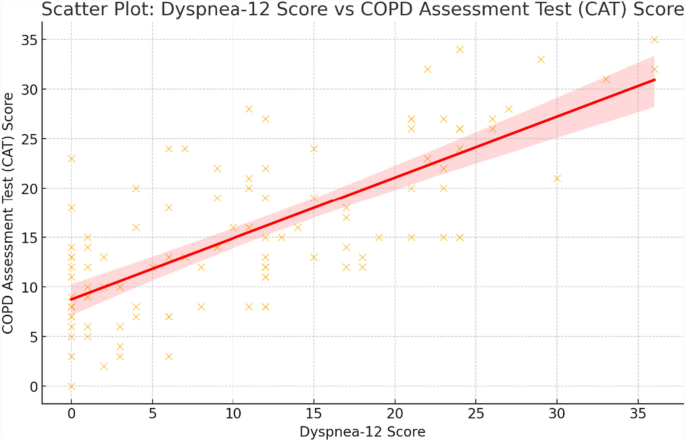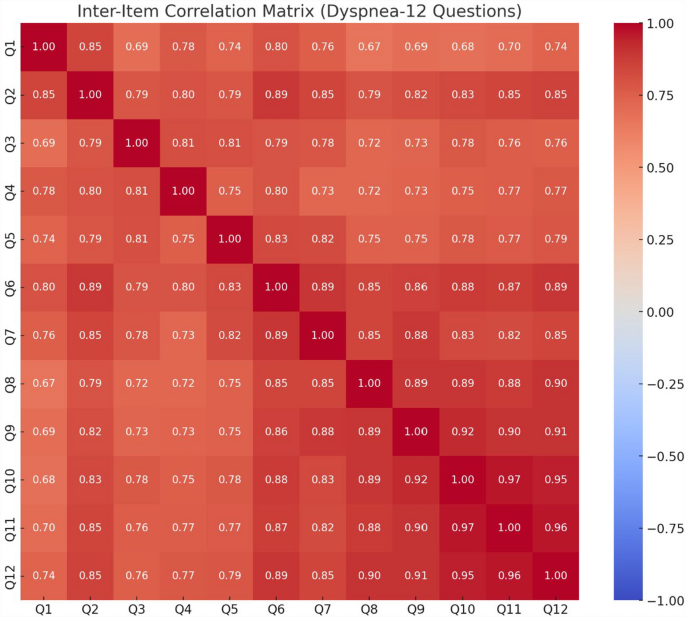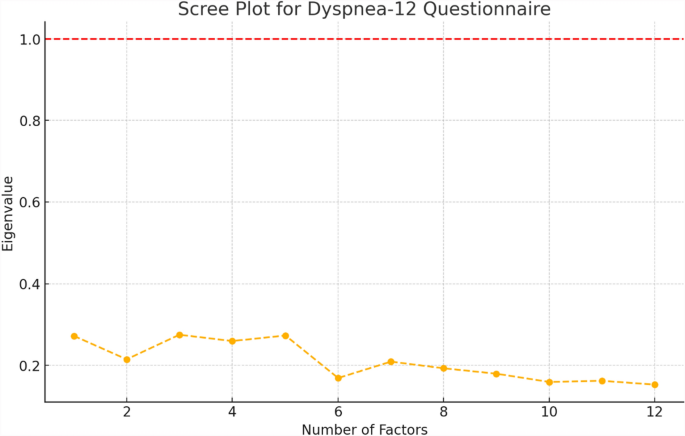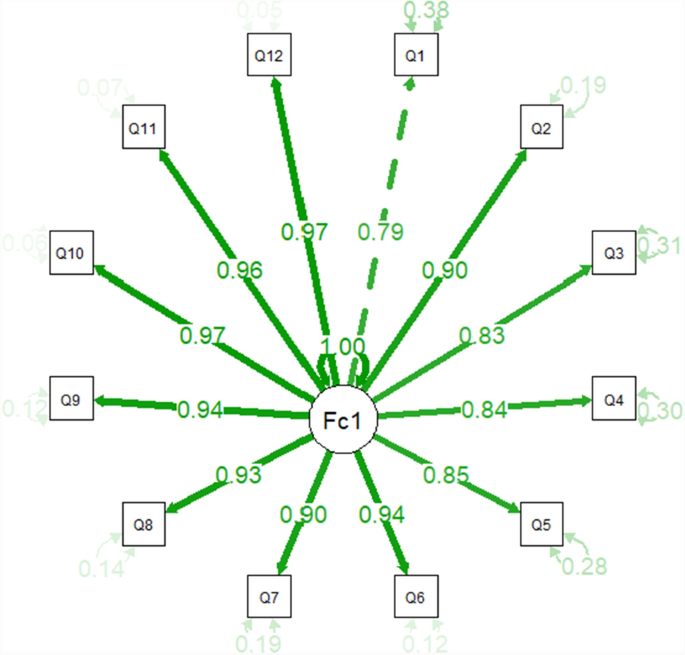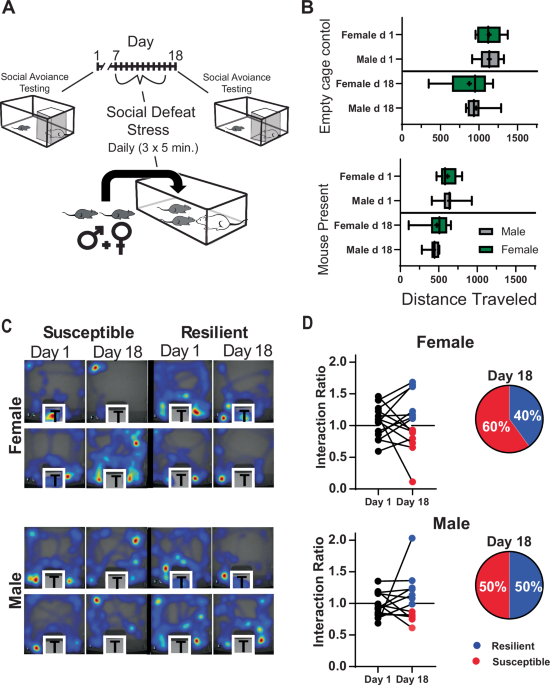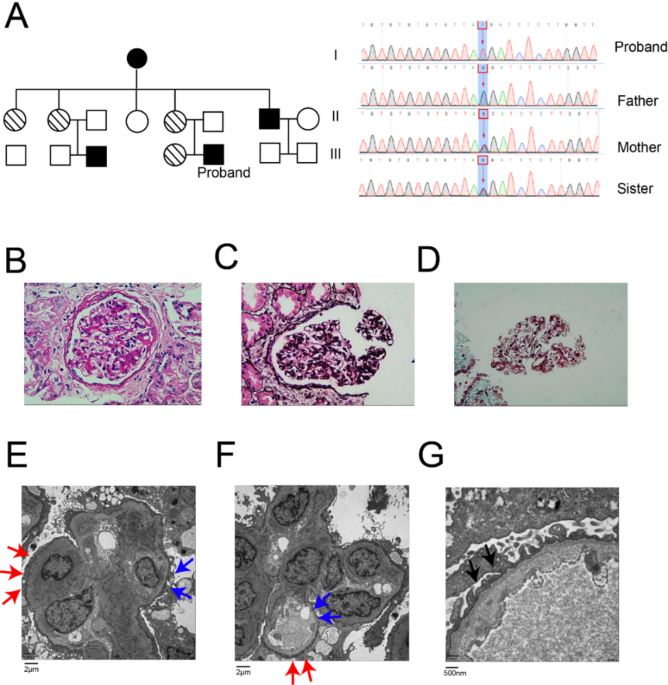BMC Research Notes volume 18, Article number: 222 (2025) Cite this article
Dyspnea is a distressing symptom of Chronic Obstructive Pulmonary Disease (COPD). The Dyspnea-12 questionnaire, a well-established instrument for assessing different dimensions of dyspnea validated in multiple languages, lacked a Persian version. This study aimed to adapt and validate a Persian version of Dyspnea-12.
The Persian version of Dyspnea-12 demonstrated excellent reliability (Cronbach's alpha = 0.982, Composite Reliability = 0.985). Criterion validity analysis strongly correlated with Dyspnea-12 and CAT scores (ρ = 0.698, p < 0.001). Factor analysis confirmed a single-factor structure consistent with the original version. Inter-item correlations ranged from 0.3 to 0.9. Construct validity indices indicated a satisfactory model fit (CFI = 0.904, SRMR = 0.044), though RMSEA (0.188) suggested areas for improvement. Pulmonary function analysis revealed significant associations between FEV₁ and Dyspnea-12 scores (p = 0.042) and FVC (p = 0.017), linking dyspnea severity with lung function decline.
Chronic Obstructive Pulmonary Disease (COPD) is a major global health concern, significantly affecting patients' quality of life and placing a burden on healthcare systems [1, 2]. Characterized by persistent respiratory symptoms and airflow limitation, COPD is primarily linked to prolonged exposure to harmful particles, especially cigarette smoke [3]. Dyspnea is a debilitating symptom in COPD, resulting in diminished physical activity, increased psychological distress, and frequent hospitalizations [4, 5]. Accurate dyspnea assessment is crucial for managing disease progression and optimizing care [6].
Over the years, numerous instruments have been created to quantify dyspnea, encompassing single-item scales such as the Modified Medical Research Council (mMRC) Dyspnea Scale and multidimensional tools [7, 8]. The Dyspnea-12 questionnaire is notable for its complete assessment of dyspnea's physical and emotional aspects [9]. The questionnaire was developed to encapsulate the complex sensation of dyspnea, rendering it a significant instrument for clinical and research applications [10], validated in multiple languages and patient groups, including asthma, interstitial lung disease, lung cancer, and heart failure, it has consistently shown high reliability and validity [11,12,13,14,15,16,17].
Dyspnea is a key and impactful symptom in COPD, and accurately assessing its physical and emotional aspects is crucial for effective interventions and outcome monitoring. Validating assessment tools for the COPD population ensures clinical relevance and prevents misestimation of symptom burden, which is vital for patient care and research accuracy.
Although Dyspnea-12 has been validated in multiple languages and patient populations, linguistic and cultural differences may influence how dyspnea is perceived and reported, underscoring the necessity for a Persian version. The absence of a validated Persian adaptation limits the accurate assessment of dyspnea in Persian-speaking COPD patients, potentially affecting clinical decision-making and research outcomes.
Consequently, we aim to translate, culturally adapt, and validate the Dyspnea-12 questionnaire for Persian-speaking patients with COPD. Specifically, we seek to evaluate its internal consistency, criterion validity, discriminant validity, and construct validity. Developing a reliable and culturally relevant instrument aims to enhance dyspnea assessment in Persian-speaking populations, ultimately improving disease management and patient outcomes [18].
A cross-sectional study was conducted to validate the Persian Dyspnea-12 in COPD patients, adhering to the Declaration of Helsinki and Good Clinical Practice guidelines. Ethical approval was obtained from the Shiraz University of Medical Sciences (IR.SUMS.MED.REC.1398.544), and all participants gave informed consent.
Given the recommendation of 4 to 10 patients per item of the questionnaire [19], although there is a suggestion of 20 cases per item [20] and that the questionnaire has 12 items and similar studies have examined between 40 and 102 patients, our goal was to recruit at least 60 patients, but ultimately enrolled 105 consecutive COPD patients referring Shahid Fghihi Hospital pulmonary function laboratory, Shiraz, Iran, from September to December 2022, whose diagnosis of COPD was previously confirmed (i.e., based on the Global Initiative for Chronic Obstructive Lung Disease criteria) [21]. We enrolled patients with nonreversible obstruction on spirometry and those diagnosed with COPD by a pulmonologist. Patients were selected if they were clinically stable and able to participate.
Participants had to be aged ≥ 18, diagnosed with COPD, fluent in Persian, and capable of independently completing the questionnaire and providing informed consent. Exclusion criteria included other major respiratory diseases, cognitive impairments, mental illness, severe infections, or recent COPD-related hospitalization.
This study utilized the Dyspnea-12 questionnaire as the primary instrument (supplementary file, Appendix 1), which was subjected to an extensive translation and cultural adaptation process per recognized international guidelines for the cross-cultural adaptation of patient-reported outcome measures (PROMs) [22]. The questionnaire serves as a means for patients to share their experiences, concentrating on evaluating the intricate nature of dyspnea concerning both physical and emotional dimensions. Created by Yorke and colleagues, this instrument includes 12 items. The items are categorized into two primary groups: one related to the physical sensations linked to dyspnea (like effort, discomfort, and air hunger) and the other addressing the emotional responses to dyspnea (such as feelings of anxiety, depression, and distress). Participants are instructed to evaluate their degree of dyspnea for each item rated on a 4-point Likert scale (0–3). Scores range from 0 to 36, with higher scores reflecting greater symptom burden [10].
Two independent bilingual translators proficient in English and Persian conducted forward translations of the original Dyspnea-12 questionnaire. The translations were consolidated into a unified version following a comprehensive comparison to resolve discrepancies. Subsequently, two native English speakers, unaware of the original questionnaire, performed backward translations of the reconciled Persian version into English.
This forward-and-back translation product then went through a review for semantic, cultural, and conceptual equivalence by the multidisciplinary committee consisting of pulmonologists, psychometricians, and linguists. A pilot with 10 patients ensured clarity and cultural relevance. The finalized Persian version was used in the main study.
Participants also completed the COPD Assessment Test (CAT), a validated 8-item tool assessing the health impact of COPD. The symptoms encompass cough, sputum production, chest tightness, dyspnea, daily activity limitations, confidence in leaving home, sleep quality, and energy levels. Items are assessed using a 6-point Likert scale from 0 to 5. The score varies from 0 to 40. An elevated score signifies an increased symptom burden and a more significant effect on the patient's quality of life [23]. The Persian version of the CAT has been validated for COPD patients in Iran, exhibiting exceptional reliability and validity as evidenced by numerous studies [24, 25].
Parameters of pulmonary function such as Forced Expiratory Volume in one second (FEV₁), Forced Vital Capacity (FVC), Total Lung Capacity (TLC), Residual Volume (RV), FEV₁/FVC ratio, and RV/TLC were obtained by expert respiratory therapists according to American Thoracic Society guidelines [26, 27].
Data analysis utilized statistical software packages, specifically the 27th version of IBM SPSS (IBM Corp., 2020, IBM SPSS Statistics for Windows, Version 27.0. Armonk, NY: IBM Corp; R version 4.4.2 (R Core Team, 2024). The normality of distribution was determined using Skewness and Kurtosis, with values between − 1 and + 1 considered normally distributed. Descriptive statistics, such as means, standard deviations, frequencies, and percentages, were employed to summarize demographic characteristics, pulmonary function test results, and Dyspnea-12 scores. The internal consistency of Persian Dyspnea-12 was measured by composite Reliability (CR) and Cronbach's alpha coefficient, where 0.7 is acceptable and above 0.9 is excellent reliability. Criterion validity was evaluated through Spearman's correlation between Dyspnea-12 and CAT scores (as the two scores were non-normally distributed, determined using Shapiro–Wilk tests and Kurtosis and Skewness values).
Construct validity was tested using Exploratory and Confirmatory Factor Analysis (EFA and CFA). Model fit was assessed using CFI, RMSEA, and SRMR. Discriminant validity was evaluated through inter-item correlations; inter-item correlation values between 0.3 and 0.9 were deemed acceptable, correlations below 0.3 are seen as low, and a value greater than 0.9 suggests that the two concepts are almost identical.
We calculated the Average Variance Extracted (AVE) and Shared Variance (SV). One-way analysis of variance (ANOVA) assessed differences in pulmonary function across Dyspnea-12 score groups, and when needed, we followed up with post hoc comparisons using the Tukey HSD test. A p-value that falls below 0.05 is considered statistically significant.
Of the 105 participants, 93.3% were male, with a mean age of 59.99 ± 9.38 years and BMI of 23.46 ± 4.13 kg/m2. Table 1 presents the pulmonary function data.
Most Dyspnea-12 responses were rated as "None" or "Mild." The item "I feel short of breath" had the highest “Severe” response (7.6%). Physical symptom items like "My breath does not go in all the way" and "My breathing requires more work" frequently received "Moderate" or "Severe" ratings (Table 2).
The mean Dyspnea-12 score was 11.27 ± 9.72, with 35.2% scoring 0–5. Higher scores were infrequent, with merely 2.9% achieving above 30, signifying severe dyspnea. The mean CAT score was 15.69 ± 8.11, indicating a moderate effect of COPD on the health status of the participants (Table 3).
Internal consistency was excellent (Cronbach's alpha = 0.982; CR = 0.985). A strong positive correlation was found between Dyspnea-12 and CAT scores (ρ = 0.698, p < 0.001), confirming criterion validity (Fig. 1).
The inter-item correlation matrix revealed moderate to strong inter-item correlations (0.3–0.9) for most items. Items Q6–Q12 exhibited robust correlations, reflecting alignment with the fundamental construct of dyspnea. Q1 demonstrated diminished inter-item correlations, suggesting possible misalignment with the remaining items, AVE = 0.816 and SV = 1.0, suggesting limitations in a single-factor discriminant validity model (Fig. 2).
The exploratory factor analysis supported a one-factor structure with high factor loadings for most items, except Q1. Furthermore, the previously discussed CR and AVE values reinforce the single-factor structure, underscoring its notable internal reliability and robust convergent validity. The assessment of the one-factor model within the framework of confirmatory factor analysis (CFA) utilizes a range of fit indices. The Comparative Fit Index (CFI = 0.904) and the Standardized Root Mean Square Residual (SRMR = 0.044) indicate the model's satisfactory fit. However, the Root Mean Square Error of Approximation (RMSEA = 0.188) indicated room for improvement. Nevertheless, the overall fit of the model was deemed moderate, with standardized factor loadings ranging from 0.79 (Q1) to > 0.9 (Q6–Q12). The residual variances were also generally low, except for Q1, exhibiting relatively higher unexplained variance (Figs. 3 and 4).
ANOVA showed significant group differences in FEV₁ (p = 0.042, η2 = 0.093) and FVC (p = 0.017, η2 = 0.112), with lower values in those with higher dyspnea scores, suggesting that greater dyspnea severity is associated with a decline in lung function.. Post hoc tests were not significant. Other parameters (FEV₁/FVC, TLC, RV, RV/TLC) were not statistically significant. Nevertheless, RV and RV/TLC exhibited small to medium effect sizes, suggesting potential trends that may merit further exploration in larger cohorts (Table 4).
Evaluating the severity of dyspnea in patients with COPD is crucial for guiding clinical decisions, refining therapeutic approaches, and enhancing health outcomes, considering its significant influence on physical function, emotional well-being, and overall quality of life [6, 28]. The Dyspnea-12 offers a multidimensional view of the symptom, capturing sensory and emotional impacts [10]. This study confirmed the reliability and validity of the Persian version in COPD patients.
Internal consistency matched other language versions, including Italian, Arabic, Korean, and Japanese [14, 15, 17, 29]. For instance, the Italian adaptation of Dyspnea-12 exhibited strong internal consistency, thus supporting the findings of our study [15]. Similarly, Al-Gamal et al. confirmed that the Arabic version demonstrated high internal reliability values, affirming the tool's robustness across various populations [17]. The variations in reliability coefficients observed in different studies are frequently linked to differences in sample characteristics, cultural interpretations of symptoms, and the methodological approaches employed. The results demonstrate that the stable internal reliability noted across various linguistic adaptations underscores the robustness of the Dyspnea-12's structural design.
The assessment of criterion validity indicates a robust correlation between the Persian Dyspnea-12 scores and the CAT scores, consistent with results from studies validating the French and Turkish translations of the Dyspnea-12 [30, 31]. For instance, the French version significantly correlated with health-related quality-of-life scales, confirming its criterion validity [31]. Similarly, the Turkish validation study also indicated a strong correlation between Dyspnea-12 scores and clinical evaluations of dyspnea severity [30].
Our findings regarding construct validity indicated a single-factor structure for the Persian Dyspnea-12, aligning with prior validations in other languages [14, 16, 29, 32]. The factor loadings for most items were robust, suggesting a strong alignment with the underlying construct of dyspnea. Item Q1 consistently showed weaker performance, as seen in Japanese and Arabic adaptations [17, 29]. This difference may indicate variations in cultural or linguistic backgrounds that influence how patients understand and express specific physical sensations associated with dyspnea.
The inter-item correlation matrix demonstrated moderate to significant connections among most items in our sample, signifying a unified structure, in line with Swedish and Italian validations [15, 16]. Inter-item correlations may change among research due to cultural disparities, sample population homogeneity, and disease severity. Given these differences, careful consideration should ensure that translated versions maintain each item's intended meaning and relevance.
The Persian Dyspnea-12 exhibited robust psychometric properties; nonetheless, minor discrepancies in the performance of individual items highlight the challenges associated with the translation and cultural adaptation of subjective assessment tools. The nuances of language and culture significantly shape how individuals perceive and express symptoms, which may lead to subtle differences in responses across various linguistic adaptations [33, 34]. In particular, the interpretation of emotional and sensory descriptors may vary, influencing the consistency of responses across different populations.
Compared to the Norwegian and French versions, our study also emphasized the importance of examining discriminant validity through metrics such as AVE and SV. While most items aligned well with the overarching construct of dyspnea, minor deviations suggest the need for cautious interpretation of specific item-level results [35]. The findings underscore the necessity of thorough cross-cultural validations to confirm that translated versions of PROMs maintain their psychometric integrity across diverse contexts. The findings of our study affirm the validity and reliability of the tool, underscoring the broader applicability of the Dyspnea-12 questionnaire across various languages and cultural contexts. Research involving Swedish, Korean, and Japanese cohorts has demonstrated the consistent effectiveness of Dyspnea-12 in clinical and research contexts, affirming its role as a universally applicable tool for assessing dyspnea [14, 16, 29].
We also observed significant associations between Dyspnea-12 scores and spirometric measures, notably lower values of FEV₁ and FVC, among participants with higher Dyspnea-12 scores, suggesting a graded relationship between dyspnea severity and impaired lung function. Although these associations reached statistical significance, the absence of significant pairwise differences in post hoc analyses indicates a more continuous than categorical distinction among symptom groups. Other parameters—including FEV₁/FVC ratio, TLC, and RV—did not exhibit statistically significant variation across Dyspnea-12 categories, although a non-significant trend toward increased RV with higher symptom burden was noted.
These results are broadly consistent with existing literature that has explored the relationship between patient-reported dyspnea and physiological measures of pulmonary function. Previous research has demonstrated inverse correlations between Dyspnea-12 scores and both FEV₁ and FVC in individuals with COPD, affirming the relevance of Dyspnea-12 as an indicator of physiological compromise [36]. Similarly, significant associations have been documented between Dyspnea-12 scores and FVC and diffusing capacity in patients with interstitial lung diseases, supporting the use of the instrument across diverse respiratory populations [9, 37].
Interestingly, while traditional spirometric indices such as the FEV₁/FVC ratio are often used in clinical staging, their association with symptom perception appears less robust. Some studies have highlighted that patients with comparable FEV₁ values may present with markedly different symptom profiles, likely reflecting variations in underlying mechanisms such as dynamic hyperinflation, inspiratory muscle inefficiency, and altered central perception of breathlessness [38]. The findings echo such observations, underscoring dyspnea's multidimensional and subjective nature. Additionally, weak correlations between dyspnea measures and lung function have been reported in prior investigations, particularly among frail COPD populations, further illustrating that conventional spirometry may not fully capture the burden of symptoms [39].
The physiological basis for the observed associations likely stems from the fact that reductions in FEV₁ and FVC reflect both obstructive and restrictive processes, heightening the mechanical load on the respiratory system. These impairments may exacerbate ventilatory inefficiency and neuromechanical dissociation, which are key contributors to the experience of breathlessness in chronic lung disease. While hyperinflation, suggested by increased RV, is a plausible contributor to dyspnea in this context, the non-significant trend observed here highlights the need for further investigation [40,41,42].
Clinically, these findings reinforce the value of incorporating the Dyspnea-12 questionnaire into routine assessment, not merely as a symptom score but as a surrogate marker of underlying functional impairment. Unlike objective pulmonary function tests, Dyspnea-12 offers a direct window into the patient's lived experience, capturing dimensions of symptom burden that spirometry alone may overlook. Future studies should consider longitudinal designs to examine whether changes in Dyspnea-12 scores parallel alterations in pulmonary function and assess the impact of therapeutic interventions on physiological and perceptual outcomes.
Although our work possesses significant attributes, including a comprehensive translation procedure and meticulous statistical analysis, it is essential to acknowledge some limitations. First, while the sample size was adequate for statistical validation, it may not fully represent the broader COPD population in Iran, particularly in terms of disease severity, demographic diversity, and geographic distribution. Second, the study was conducted in a single-center setting, which may limit the generalizability of the findings to other healthcare settings. Third, our reliance on self-reported data introduces the possibility of response biases, particularly in the perception and reporting of dyspnea symptoms. Finally, the absence of a test–retest reliability assessment prevents us from evaluating the questionnaire's temporal stability, which is crucial for determining its consistency over time. Future research should address these limitations by incorporating a more diverse sample, multi-center recruitment, and longitudinal assessments to validate the Persian Dyspnea-12 further.
The study had several limitations: (1) Although the sample size was adequate, it may not represent Iran's broader COPD population in terms of severity, demographics, and geography, limiting generalizability; (2) As a single-center study, its findings may not extend to other healthcare settings, emphasizing the need for multi-center research; (3) Reliance on self-reported dyspnea data introduces subjectivity and potential recall bias, suggesting the value of incorporating objective measures; (4) While construct validity was generally supported, minor item-level deviations (e.g., Q1) indicate a need for further psychometric testing, including cross-cultural comparisons and qualitative feedback.
The Persian version of the Dyspnea-12 questionnaire demonstrated robust validity, reliability, and structural integrity, aligning with findings from previous international validations. This instrument assists physicians and researchers in thoroughly comprehending and measuring the subjective experience of dyspnea in Persian-speaking COPD patients. Future studies should examine the responsiveness of this version to therapeutic therapies and evaluate its longitudinal validity in broader, more diverse populations.
The datasets used and/or analyzed during the current study are available from the corresponding author upon reasonable request.
The present study was financially supported by the vice-chancellor for research at Shiraz University of Medical Sciences (grant No. 18552).
This study was conducted in accordance with the ethical principles outlined in the Helsinki Declaration. All participants gave their informed consent before their inclusion in the study. The study protocol was approved by the Ethics Committee of Shiraz University of Medical Sciences (Ethics code: IR.SUMS.MED.REC.1398.544).
Not applicable.
The authors declare no competing interests.
Springer Nature remains neutral with regard to jurisdictional claims in published maps and institutional affiliations.
Open Access This article is licensed under a Creative Commons Attribution-NonCommercial-NoDerivatives 4.0 International License, which permits any non-commercial use, sharing, distribution and reproduction in any medium or format, as long as you give appropriate credit to the original author(s) and the source, provide a link to the Creative Commons licence, and indicate if you modified the licensed material. You do not have permission under this licence to share adapted material derived from this article or parts of it. The images or other third party material in this article are included in the article’s Creative Commons licence, unless indicated otherwise in a credit line to the material. If material is not included in the article’s Creative Commons licence and your intended use is not permitted by statutory regulation or exceeds the permitted use, you will need to obtain permission directly from the copyright holder. To view a copy of this licence, visit http://creativecommons.org/licenses/by-nc-nd/4.0/.
Alishapour, E., Nayeri, M.A., Bahrami, R. et al. Validity and reliability of the persian version of the dyspnea-12 questionnaire in assessing dyspnea among COPD patients. BMC Res Notes 18, 222 (2025). https://doi.org/10.1186/s13104-025-07290-4
Received:
Accepted:
Published:
DOI: https://doi.org/10.1186/s13104-025-07290-4
